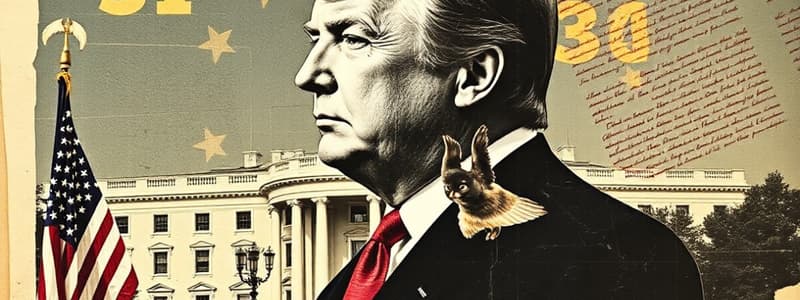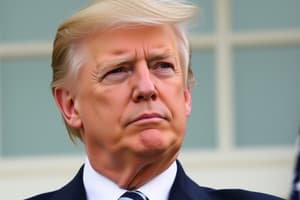Podcast
Questions and Answers
Which of the following is NOT a constitutional requirement to become President of the United States?
Which of the following is NOT a constitutional requirement to become President of the United States?
- Having lived in the United States for at least 14 years.
- Having prior military experience.
- Being a natural born U.S. citizen.
- Being at least 35 years old. (correct)
The 22nd Amendment to the United States Constitution directly addresses what aspect of the presidency?
The 22nd Amendment to the United States Constitution directly addresses what aspect of the presidency?
- The process of presidential impeachment.
- The establishment of the Electoral College.
- The limitation of a president to two terms in office. (correct)
- Presidential succession in cases of death or disability.
What is required for the US Senate to ratify treaties negotiated by the President?
What is required for the US Senate to ratify treaties negotiated by the President?
- A unanimous vote.
- Approval by the Chief Justice of the Supreme Court. (correct)
- A simple majority vote.
- A two-thirds majority vote.
What is the function of the Executive Office of the President (EOP)?
What is the function of the Executive Office of the President (EOP)?
Which scenario illustrates the 'checks and balances' principle related to the President's cabinet?
Which scenario illustrates the 'checks and balances' principle related to the President's cabinet?
What is the primary distinction between 'independent agencies' and 'government corporations'?
What is the primary distinction between 'independent agencies' and 'government corporations'?
Which of the following exemplifies the 'bureaucratic inertia' problem within the federal government?
Which of the following exemplifies the 'bureaucratic inertia' problem within the federal government?
What is the significance of the Whistleblower Protection Act?
What is the significance of the Whistleblower Protection Act?
Which of the following presidential actions does NOT require Congressional approval?
Which of the following presidential actions does NOT require Congressional approval?
What distinguishes an 'executive agreement' from a treaty?
What distinguishes an 'executive agreement' from a treaty?
How can Congress check the power of the President to appoint officials to positions within the federal government?
How can Congress check the power of the President to appoint officials to positions within the federal government?
Which of the following scenarios best illustrates 'inter-governmental conflict' as it relates to the US bureaucracy?
Which of the following scenarios best illustrates 'inter-governmental conflict' as it relates to the US bureaucracy?
What is the role of the 'Chief of Staff' within the Executive Office of the President?
What is the role of the 'Chief of Staff' within the Executive Office of the President?
A presidential veto can be overridden by what proportion of both the House and Senate?
A presidential veto can be overridden by what proportion of both the House and Senate?
What is the 'power of pardon' as it relates to presidential authority?
What is the 'power of pardon' as it relates to presidential authority?
Flashcards
Presidential Veto
Presidential Veto
The power to reject a bill passed by Congress; can be overridden by a 2/3 vote in each house.
Negotiate Treaties
Negotiate Treaties
Agreements with other countries that require a 2/3 Senate approval.
Appointment Power
Appointment Power
Power to appoint officials within the federal government, including the federal judiciary.
Pardoning Power
Pardoning Power
Signup and view all the flashcards
Executive Orders
Executive Orders
Signup and view all the flashcards
Executive Agreements
Executive Agreements
Signup and view all the flashcards
The Cabinet
The Cabinet
Signup and view all the flashcards
Secretaries
Secretaries
Signup and view all the flashcards
Independent Agencies
Independent Agencies
Signup and view all the flashcards
Independent Regulatory Boards & Commissions
Independent Regulatory Boards & Commissions
Signup and view all the flashcards
Government Corporations
Government Corporations
Signup and view all the flashcards
Inter-government Rivalry
Inter-government Rivalry
Signup and view all the flashcards
Bureaucratic Inertia
Bureaucratic Inertia
Signup and view all the flashcards
Whistleblowers
Whistleblowers
Signup and view all the flashcards
Presidential Requirements
Presidential Requirements
Signup and view all the flashcards
Study Notes
Lesson 9: The Executive Branch
Requirements to Be President
- Article II, Section 1 of the US Constitution outlines presidential requirements.
- Must be a natural-born U.S. citizen, including those born in the U.S. or abroad to U.S. citizen parents under certain conditions
- Must be at least 35 years old on Inauguration Day
- Must have lived in the United States for at least 14 years (not necessarily consecutive).
Constitutional Amendments
- Several amendments address the office of the president.
- The 12th Amendment modified the Electoral College to prevent presidents and vice presidents from opposing parties by having them elected on separate ballots.
- The 20th Amendment set January 20 as the official day for terms of office and states that if the president dies before taking office, the VP shall take over
- The 22nd Amendment limits the president to two terms
- The 25th Amendment allows the VP and a majority of the cabinet or Congress to remove a president deemed unable to perform their job
Powers of The President
- The president has the following powers:
- Presidential Veto: Authority to reject a bill passed by Congress, which can be overridden by a 2/3 majority in each house
- Negotiate: enter into agreements with other countries, requiring 2/3 Senate approval
- Tariffs: Can impose tariffs, but is usually tied to national security or unfair trade practices through Congressional laws
- Appointment power: Appoints thousands of positions within the federal government, including the entire judiciary
- Pardoning: Releases or excuses a person from legal punishment, such as prison time or fines, and can be given before conviction.
- Executive Privilege: Ability to keep confidential certain elements concerning the executive branch or national security
- Executive order: Clarifications of congressional policy issued by the president, having the full force of law but can be challenged in court or undone by other factors
The Executive Office of the President
- The Executive Office of the President (EOP) supports the President.
- It was created in 1939 by Franklin D. Roosevelt
- It handles tasks from communicating messages to promoting trade interests.
- EOP members serve at the President's will and typically do not require Senate approval.
- The Chief of Staff heads the EOP, overseeing White House staff operations and controlling access to the President.
Executive Departments
- The President's Cabinet serves as a group of close advisors, consisting of the heads of the executive departments and other key appointed officials
- It advises the President and helps implement policies.
- Heads of executive departments (Secretaries) are nominated by the President and confirmed by the Senate.
- The Senate conducts hearings, evaluates qualifications, and votes on these nominees.
The Bureaucracy
- A bureaucracy is an administrative group of non-elected officials who carry out functions connected to a series of policies and programs.
- Independent Agencies: organizations within the executive branch that execute the law and that are separate from the departments with a presidential appointee at the top (e.g., FEC, SSA, NASA).
- Independent Regulatory Boards and Commissions: regulate various businesses, industries, or economic sectors with a presidential appointee at the top (e.g., FDA, NTSB, NLRB, SEC).
- Government Corporations: Fill some commercial function important but not profitable enough for private industry. (e.g., AMTRAK or USPS).
Power of the Bureaucracy
- Broad language in laws gives more power to bureaucratic agencies to carry out the law as they see fit.
- A common criticism of the bureaucracy is that unelected officials are tasked with creating rules that the public must abide by.
- In 1972, the Consumer Product Safety Act tasked the CPSC with reducing unreasonable risk of injury from household products but offered no guidance on what constitutes "reasonable" or "unreasonable" risks.
Problems With The Bureaucracy
- Inter-government clashes between agencies occur as they vie for budgetary funds, public support, and clientele groups.
- Bureaucratic red tape refers to the accepted values and procedures of an organization leading to a culture of conform and cover up.
- Inefficiency occurs because there is no incentive to be fiscally responsible or to turn a profit.
- Whistleblower protection exists for those exposing wrongdoings in the bureaucracy.
- Congress passed the Whistleblower Protection Act in 1989 to protect whistleblowers, but this is not guaranteed.
Studying That Suits You
Use AI to generate personalized quizzes and flashcards to suit your learning preferences.
Related Documents
Description
Explore the requirements to be President of the United States as outlined in Article II, Section 1 of the Constitution. Learn about the 12th, 20th, 22nd, and 25th Amendments, each addressing critical aspects of the presidential office, such as Electoral College modifications, term limits, and presidential disability.




